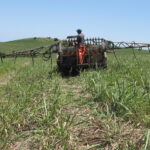It is now spring when we’re expecting rainfall and warmer temperatures, particularly in the sugarcane growing parts of South Africa. This should be good for enabling sugarcane growth and ripening, leading to increased sucrose content – all through natural means.
However, we know that environmental and natural processes are not always synchronised or sufficient to effectively enable good yields in sugarcane or any other crop. Traditionally and historically, sugarcane growers have utilised drying-off as a natural ripening strategy and synchronised this with harvesting schedules. To achieve this requires good environmental conditions with sufficient water supply. Unfortunately, different weather conditions could lead to poor ripening and low yields at harvest.
In this edition of the Link we discuss innovative approaches towards sustainable agricultural production.
Recently, we have explored an innovative approach of participatory research methodology between sugarcane growers in the Midlands South region and SASRI scientists. The focus is on deploying chemical ripening techniques to increase culm sucrose content in plants. Previous scientific studies have shown that sucrose content in the more mature parts of the culm, where the internodes have already fully elongated at the time of application of chemical ripener often result in the largest improvement in sucrose content. Responses to chemical ripeners has also been previously observed to be dependent on various factors, in particular, cultivar characteristics. We discuss in this article sugarcane varieties N41 and N48 trials through participatory research that chemical ripening induced higher sucrose content, which led to better financial returns for growers.
Pests and diseases are known factors that can adversely affect crop growth, production and yield. To ensure sustainable production and productivity, growers adopted agrochemicals known to protect crops, including sugarcane. However, the use of some agrochemicals has been demonstrated to be harmful to non-target species and in some instances led to unintended biological or environmental consequences. In response, SASRI is leading efforts towards enabling good management practices for environmental stewardship. Hence the need to explore the use of alternatives to traditional agrochemicals, such as resistance inducers and agricultural biologicals. Developing alternatives to agrochemicals for sustainable crop protection could ensure production and productivity; that in turn, could accelerate better management practices on farms.
In South Africa there are no less than 23 900 small-scale growers of sugarcane distributed from the Lowveld, Midlands to South-Coast. Sugarcane small-scale growers are known to experience various challenges that negatively affect production and productivity, that consequently result in lower incomes. In this article we explore the use of participatory research methodology by SASRI to facilitate learning by growers to increase their yields and productivity. Demographically diverse small- scale growers from 11 sugarcane communities (lowveld to south-coast) participated in this study. Through this interactive approach, small-scale growers appreciated learnings that identified various constraints, such as weed management, knowledge of various agrochemicals for weed management, cultivar selection and identification, harvest synchronisation with contractor’s haulage, to mention a few. Although still work in progress, we hope that insights developed through this methodology will enable small-scale growers to increase their yields and productivity – and lead to higher incomes.
Sustainable sugarcane production and productivity requires attention to soil health and good crop nutrients. Growers need to select appropriate fertilisers that provide the correct elements with the right application rates at lowest cost for sugarcane production. To enable growers to achieve their goals for optimal sugarcane production and productivity, SASRI has developed a decision support tool, named OptiFert. The aim is to assist growers to calculate the cheapest fertiliser option that will supply the required nutrients to their crops within specified upper and lower range limit that are based on recommendations they received from SASRI’s Fertiliser Advisory Service (FAS). In this article we announce the availability of OptiFert and how growers could make use of this important decision-support tool for their production.
Our regular feature “Topical Tips” carries seasonal advice on sugarcane production, including managing pests, diseases, weeds and nutrition. Our other regular Weather article provides a weather review and outlook for the months ahead.
It is our considered hope that this edition of the Link will provide insights for sustainable sugarcane production with improved profitability. At SASRI we aim to continuously improve our offerings for better management practices.








